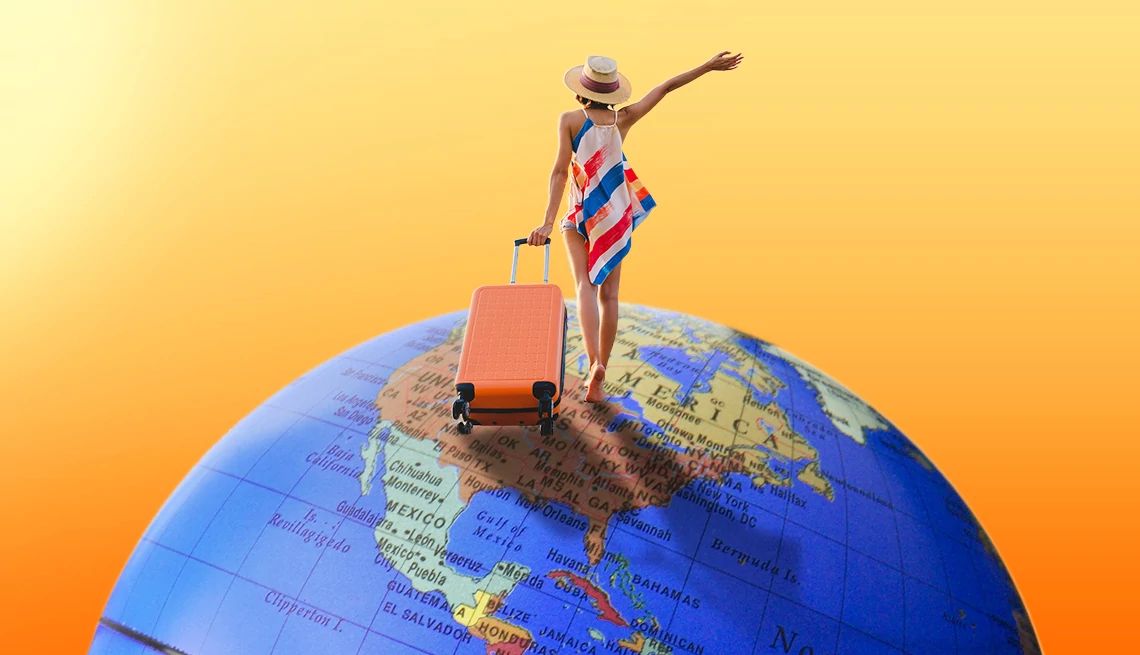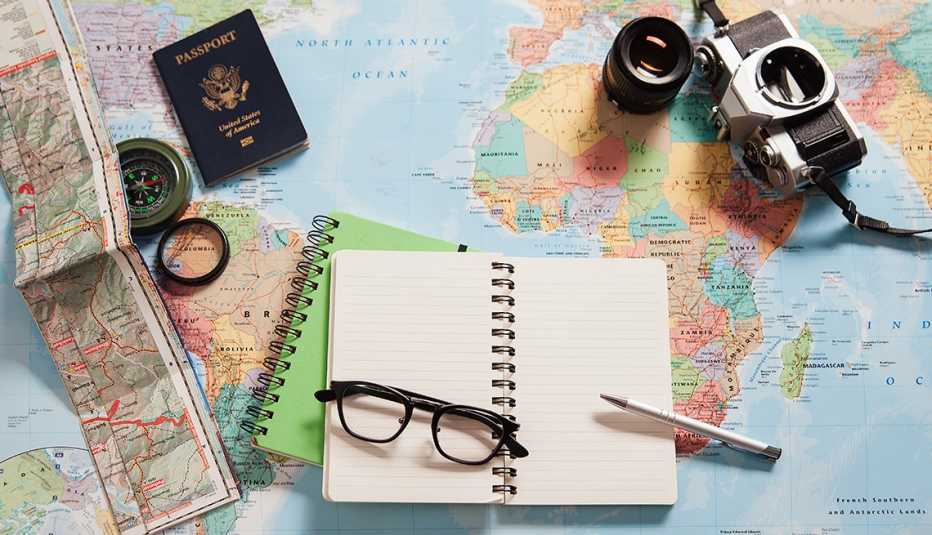AARP Hearing Center


In this story
AARP’s 2024 Travel Trends report shows that solo travel remains popular for the 50-plus crowd. While trends such as calm-cations, transformative travel and couples vacationing separately contribute to that popularity, a November 2023 survey by the website Solo Traveler shows that the most powerful motivator for solo travel is wanting to see the world without waiting for others. In addition to flexibility and independence, go-it-aloners also praise the opportunities for personal growth and the joys of meeting new people.
Writer Karla Zimmerman has contributed to more than 80 Lonely Planet guidebooks and has traveled alone extensively for both business and pleasure. People often ask her whether she is fearful or misses having companions. “Maybe a little,” she says. “But the trade-off is huge: the freedom to experience a place how I want, when I want. Like, blow off the vaunted art museum to drink beer in a pub? No problem; I just do it. Visit the famous church or the world’s largest ketchup bottle? No judgment or compromises when I choose the latter. Plus, when I’m by myself, I meet more people and pay more attention to what’s around me. The feeling of self-reliance of doing it all solo is pretty cool, too.”


WHY TRAVEL SOLO?
1. Your time, your way
Solo travelers relish the ability to decide their own schedules — from the timing of trips overall to navigating airports, meals, excursions and even rest. “I love letting my body fall into its natural sleep patterns,” says Auburn Scallon, a lifelong night owl and author for Moon Guides, travel guidebooks written by local experts. “The freedom to set my own schedule means I can plan activities around my energy levels and not have to trudge through an overly chipper early morning tour wishing I’d had enough sleep to actually enjoy it.”
2. Find flexibility in booking
Going it alone can open up opportunities that might not be available to couples or larger groups. “Utilize your advantage,” says Marie Javins, editor in chief of DC Comics and author of Stalking the Wild Dik-Dik, a travel memoir about her solo adventure across the continent of Africa. “There are often single seats left, sometimes even with discounts. It’s much easier to get that last seat on a bus, on a rafting trip, on that small plane to see polar bears when you’re only booking for one.” In a similar vein, solo travelers often can score close-up views at concerts and sports events.
3. Embark on a personal journey
Solo travel can be transformative. Javins relishes focusing on her own experiences, rather than chewing things over with a companion. “I experience the world best when I’m only responsible for my own reactions,” she says. “And I enjoy escaping from work where I am responsible for many others as well as myself.”
4. Add to your skill set
A trip with a clear framework can often help solo travelers, whether it’s a dude ranch, culinary boot camp, knitting cruise or photography workshop. Some vacations can be more explicitly educational, such as Ph.D.-led tours from Context or NOLS expeditions that teach wilderness skills. You can also dive even deeper into learning with Road Scholar, a not-for-profit organization that provides educational travel programs primarily geared toward older adults.
5. Be spontaneous
“I hear from participants a lot that they travel solo because it’s too hard to coordinate with the schedules of their friends and family,” says Kelsey Knoedler Perri, the director of public relations for Road Scholar. “Retirees are so busy these days, from yoga to volunteering, grandkids and lifelong learning classes. When you go solo, you can travel wherever and whenever works for you.” These impulsive vacationers are on-trend, it turns out. Almost 80 percent of travelers see the appeal of “on a whim” trips, and 44 percent prefer to depart without complete itineraries, according to the American Express 2024 Global Travel Trends Report. Appreciate flexibility and spontaneity on the road? Consider apps that release last-minute deals, such as HotelTonight, Booking.com and LivingSocial.
6. Take a time-out from friends and family
The hottest new travel companions are “me, myself and I,” especially for women. A 2023 Road Scholar study reveals that 60 percent of its solo travelers each year are married — and 85 percent of those senior soloists are women. Among women, the most common reasons given are “My spouse isn’t interested in traveling” and “We have different interests, so we go on trips solo or with other people.” Maureen Gordon has seen plenty of this in her role as co-owner and manager of Maple Leaf Adventures, which runs expedition cruises into Alaska and British Columbia, Canada. “At a certain point, you realize, ‘I could just go,’ especially on an adventure travel trip,” she says. “There will be other people with whom I can engage if I need that. But my soul is going to get full, then I’ll come home and have the rest of my life with my spouse.”
7. Use the opportunity to grieve
The road also rises up to meet those dealing with grief, Gordon notes. “We’ve had a number of guests getting over the loss of their partners, whom they always traveled with before,” she says. “Often, it’s the first trip they organized on their own — or in decades. It can be a very healing process.” The crew and guides frequently don’t know the stakes until later. “Then the guests write, saying how the trips gave them confidence to continue traveling that way and how much it rejuvenated their spirits,” Gordon says.


PLANNING YOUR TRIP
8. Scour for special options — or ask
Traditionally, cruises and tours based their rates on double occupancy; they added surcharges, known as single supplements, for private accommodations — anywhere from 10 percent to 100 percent of the usual rate. But roughly a decade ago, as demand for solo travel rose, some companies started reducing those fees or even waiving them. Other companies began securing more single rooms and increasing options for unaccompanied guests, notes Sarah Reid, lead author of Lonely Planet’s Solo Travel Handbook. She recommends Intrepid, G Adventures and Exodus Adventure Travels. Other standouts include Avalon Waterways, Travel Divas and Overseas Adventure Travel, with the latter specializing in trips for those age 50 and above. Brands sometimes offer seasonal or last-minute deals that scrap the single supplements. Can’t find the right package for your budget? Ask the operator about options, or see if a travel agent can negotiate.
9. Discover solo trips and deals
Tourism operators are creating more bespoke options. Notably, travelers without companions have the run of entire ships on some Riviera River Cruises. As the company’s site says, “You can book that Diamond Deck Suite you’ve always imagined, without the roommate and the single price tag.” Singles Cruises and Tours also caters to folks who would like to vacation solo — but not alone. Don’t be fooled by the name: These expeditions don’t resemble speed dating with suitcases. Instead, they connect people to the discounts and conveniences of group travel without a forced single supplement.
10. Look for small-group tours
Scott Cundy, co-owner of Wildland Trekking, a backpack and hiking tour company in Flagstaff, Arizona, recommends guided small-group tours, which increasingly attract companionless adventurers. “With a higher level of safety and a professional guide leading the tour, solo travelers are able to relax more and focus on enjoyment,” he says. And, of course, Cundy notes the social component: “Traveling with others is simply more fun,” he says.


































































You Might Also Like
Find the Best Vacation Rental
From pet-friendly accommodations, to how to save money and what you should do as soon as you arrive, read our tips
Train Travel Bucket List
If you love trains and visiting national parks, here are five trips you should take
Smart Guide to Electric Cars
Which vehicle to choose, tips to properly charge it, how to get incentives and more
Recommended for You